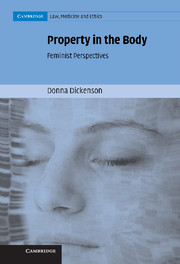Book contents
- Frontmatter
- Contents
- Acknowledgements
- Preface
- 1 Do We All Have ‘Feminised’ Bodies Now?
- 2 Property, Objectification and Commodification
- 3 The Lady Vanishes: What's Missing from the Stem Cell Debate
- 4 Umbilical Cord Blood Banks: Seizing Surplus Value
- 5 The Gender Politics of Genetic Patenting
- 6 Biobanks: Consent, Commercialisation and Charitable Trusts
- 7 The New French Resistance: Commodification Rejected?
- 8 Tonga, the Genetic Commons and No Man's Land
- 9 Afterword
- Bibliography
- Index
8 - Tonga, the Genetic Commons and No Man's Land
Published online by Cambridge University Press: 15 December 2009
- Frontmatter
- Contents
- Acknowledgements
- Preface
- 1 Do We All Have ‘Feminised’ Bodies Now?
- 2 Property, Objectification and Commodification
- 3 The Lady Vanishes: What's Missing from the Stem Cell Debate
- 4 Umbilical Cord Blood Banks: Seizing Surplus Value
- 5 The Gender Politics of Genetic Patenting
- 6 Biobanks: Consent, Commercialisation and Charitable Trusts
- 7 The New French Resistance: Commodification Rejected?
- 8 Tonga, the Genetic Commons and No Man's Land
- 9 Afterword
- Bibliography
- Index
Summary
In the previous chapter I evaluated the extent to which the official French view of the body as une chose hors commerce has provided a bulwark against commodification. In contrast to that example from the developed world, here in this chapter I want to analyse an instance from the global South: the Tongans' resistance to commodification of their genome. Despite their different provenance, the two case studies offer striking parallels. Coincidentally, diabetes research, based on mapping population genomes, was the subject of both the research project analysed by Rabinow in his book French DNA and the venture sought in Tonga by the Australian firm Autogen. In one case the government itself blocked the project – perhaps surprisingly, the French case. In the Tongan instance, it was left up to a popular resistance movement to scupper the proposal. Resistance to these particular ventures was successful in both cases, although as I suggested in the previous chapter, less than typical in the French instance. The two examples both demonstrate a view of the body as tapu or sacred, in contradistinction to the body as tool, a distinction which can also be drawn in feminist terms, between sacred and ‘open-access’ bodies. Women's bodies are likewise nominally regarded as inviolable or sacred, but in practice are used in an instrumental fashion.
The Tongan example also suggests a tantalising and powerful analogy between the legal understanding of human tissue and the human genome as res nullius and the notion of terra nullius, recently developed by Carole Pateman as an extension of her thinking on the sexual contract.
- Type
- Chapter
- Information
- Property in the BodyFeminist Perspectives, pp. 162 - 178Publisher: Cambridge University PressPrint publication year: 2007



